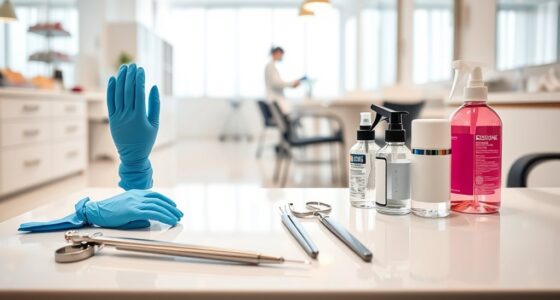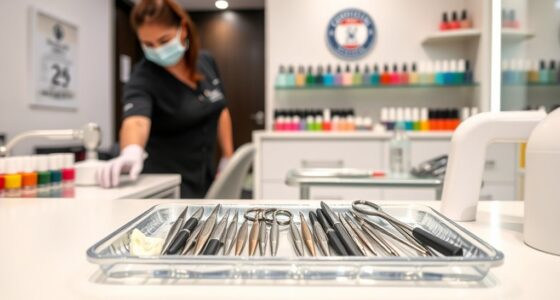To prevent salon infections, you must properly sanitize pedicure tubs after each use. Start by thoroughly cleaning surfaces to remove debris, then disinfect with EPA-approved solutions suitable for your tub type. Regularly rinse and dry the equipment, and use gloves and brushes to guarantee thorough cleaning of all crevices. Maintaining strict sanitation practices and staff training are key. Keep compliance checklists and logs—continue to explore ways to keep your salon safe and hygienic.
Key Takeaways
- Regularly clean and disinfect pedicure tubs after each client using EPA-approved solutions compatible with the surface.
- Remove debris, soap scum, and biofilm buildup through thorough scrubbing, especially in corners and crevices.
- Rinse tubs with clean water to eliminate chemical residues and prevent cross-contamination.
- Train staff consistently on sanitation protocols and monitor compliance through checklists and routine inspections.
- Document cleaning procedures and conduct routine audits to ensure adherence to health standards and prevent infections.
Understanding the Importance of Proper Pedicure Tub Sanitation

Proper sanitation of pedicure tubs is essential for preventing the spread of infections and ensuring client safety. When you maintain a clean tub, you reduce bacteria, fungi, and viruses that can cause infections. This not only protects your clients but also promotes nail polish safety, preventing contamination that could spoil the polish or cause skin reactions. Additionally, a sanitized tub enhances customer comfort, making clients feel confident in your hygiene practices. Cleanliness shows you care about their health and experience, encouraging repeat visits and positive reviews. Proper sanitation routines also help you comply with health regulations, avoiding potential fines or closures. Furthermore, maintaining proper disinfecting procedures can improve the overall color accuracy of your tools and surfaces, contributing to a safer and more professional environment. Ultimately, investing time in thorough cleaning safeguards both your clients and your business, reinforcing your commitment to quality and safety in every pedicure.
Types of Contaminants Commonly Found in Pedicure Tubs
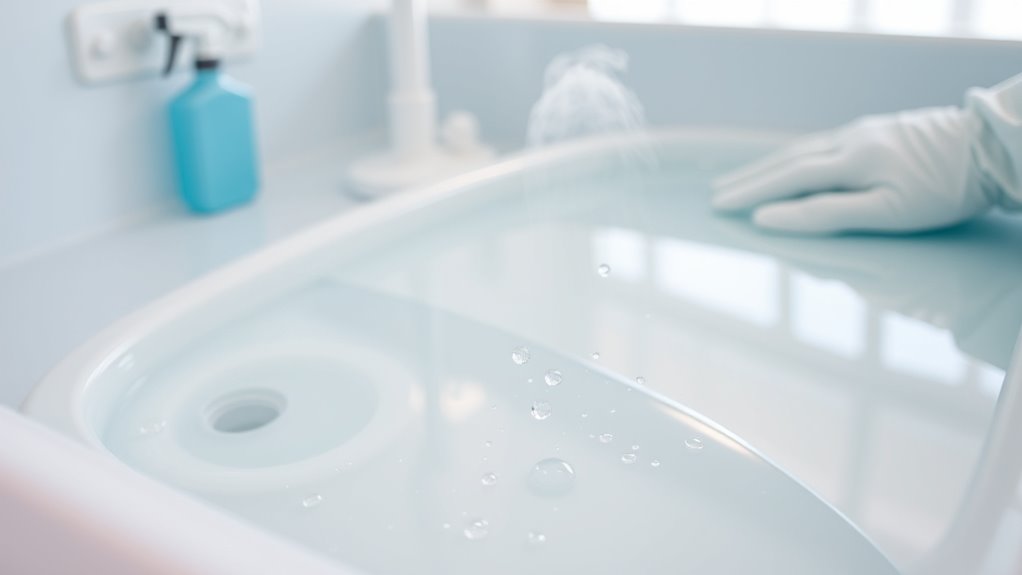
Despite thorough cleaning routines, pedicure tubs can still harbor a variety of contaminants that pose health risks. One common issue is biofilm buildup, a sticky layer of bacteria, soap scum, and dead skin cells that cling to tub surfaces. Biofilms are resistant to regular cleaning and can protect harmful microbes, making disinfection less effective. Additionally, fungal spores can be present, often originating from contaminated water or tools. These spores can cause infections like athlete’s foot or fungal nail infections if not properly eliminated. Other contaminants include bacteria such as Pseudomonas aeruginosa, which can lead to infections or skin irritations. Recognizing these common contaminants underscores the need for rigorous sanitation practices to ensure a safe pedicure experience for your clients. Proper sanitation can also help maximize space and organization in your salon by minimizing the need for re-cleaning due to persistent contamination.
Step-by-Step Guide to Effective Tub Cleaning and Disinfection

Start by gathering all your cleaning supplies so you’re ready to work efficiently. Next, remove any debris and scrub the tub thoroughly to eliminate dirt and residues. Be sure to pay special attention to local ingredients and flavors that may have accumulated on the surface. Finally, disinfect the entire surface carefully to guarantee it’s safe for the next client.
Gather Cleaning Supplies
Before you begin cleaning, gather all the supplies you’ll need to guarantee the process is efficient and thorough. You’ll want to have your cleaning supplies ready, including disinfectant solutions, scrub brushes, microfiber cloths, and gloves. Make sure your sanitation tools are clean and in good condition to avoid cross-contamination. It’s helpful to have a spray bottle for disinfectant, a bucket for rinsing, and a scraper if needed to remove any stubborn residues. Double-check that all items are suitable for use in a salon environment and follow manufacturer instructions. Ensuring the effectiveness of disinfectants is crucial for proper sanitation. Gathering everything beforehand prevents interruptions and ensures you don’t forget any essential supplies during the cleaning process. Being prepared streamlines your work and promotes a safe, hygienic pedicure station.
Remove and Scrub Tub
Once you’ve gathered your cleaning supplies, it’s time to remove any debris or residue from the tub’s surface. Start by inspecting the tub and removing any hair, soap scum, or other visible debris. Use a damp cloth or disposable wipes to wipe away surface dirt. Next, scrub the surfaces thoroughly with a soft brush or sponge, paying attention to corners and crevices where grime can hide. Focus on removing debris lodged in seams or around fixtures. This step ensures the tub is free of visible contaminants before disinfection. Properly scrubbing the surfaces helps loosen buildup and prepares the tub for effective sanitation. Additionally, inspecting for any surface damage or cracks can help prevent bacteria buildup and ensure thorough cleaning. Take your time, and ensure every area is cleaned, so the subsequent disinfecting process is more effective.
Disinfect Thoroughly
To make certain your pedicure tub is truly sanitized, it’s essential to disinfect it thoroughly after cleaning. This step ensures all germs and bacteria are eliminated, reducing infection risk. Use an EPA-approved disinfectant suitable for salon equipment, following the manufacturer’s instructions for dilution and contact time. Make sure to cover all surfaces, including hard-to-reach areas, to disinfect thoroughly. Proper disinfection not only sanitizes equipment but also maintains a safe environment for clients and staff. Additionally, using appropriate disinfectant technology can enhance the effectiveness of your sanitation process. Use gloves and eye protection to prevent chemical exposure. Allow the disinfectant to sit for the recommended contact time. Rinse with clean water to remove residual chemicals before reuse.
Choosing the Right Sanitizing Products for Pedicure Equipment

Choosing the right sanitizing products for pedicure equipment is essential to guarantee a safe and hygienic experience for clients. You want products that effectively eliminate bacteria and fungi without harsh chemicals. Consider using sanitizers infused with essential oils, which can add a natural antimicrobial boost and leave a pleasant scent. UV sterilizers are also a great option; they disinfect tools quickly and thoroughly without chemicals, reducing residue buildup. When selecting products, check for EPA approval and ensure they’re compatible with your equipment materials. Consistency is key—use the chosen sanitizers as recommended to maintain high hygiene standards. Properly combining natural solutions like essential oils with advanced tools like UV sterilizers can considerably reduce the risk of infections and create a safer salon environment. Additionally, implementing proper cleaning protocols ensures ongoing hygiene and minimizes the chance of microbial contamination.
Best Practices for Maintaining a Hygienic Salon Environment

Maintaining a hygienic salon environment goes beyond selecting the right sanitizing products; it requires consistent and thorough cleaning routines. To ensure pedicure safety and uphold salon hygiene, you should establish clear protocols for daily and weekly cleaning tasks. Regularly disinfect workstations, tools, and high-touch surfaces to prevent cross-contamination. Use specialized cleaning solutions for pedicure tubs and follow manufacturer instructions. Incorporate these best practices for a spotless, safe environment:
- Schedule routine deep cleaning of all equipment and surfaces
- Implement strict hand hygiene policies for staff and clients
- Regularly review sanitation procedures and update protocols as needed
- Incorporate sound design techniques to enhance the auditory environment, which can also contribute to a calming and hygienic salon atmosphere
Training Staff on Sanitation Protocols and Standards
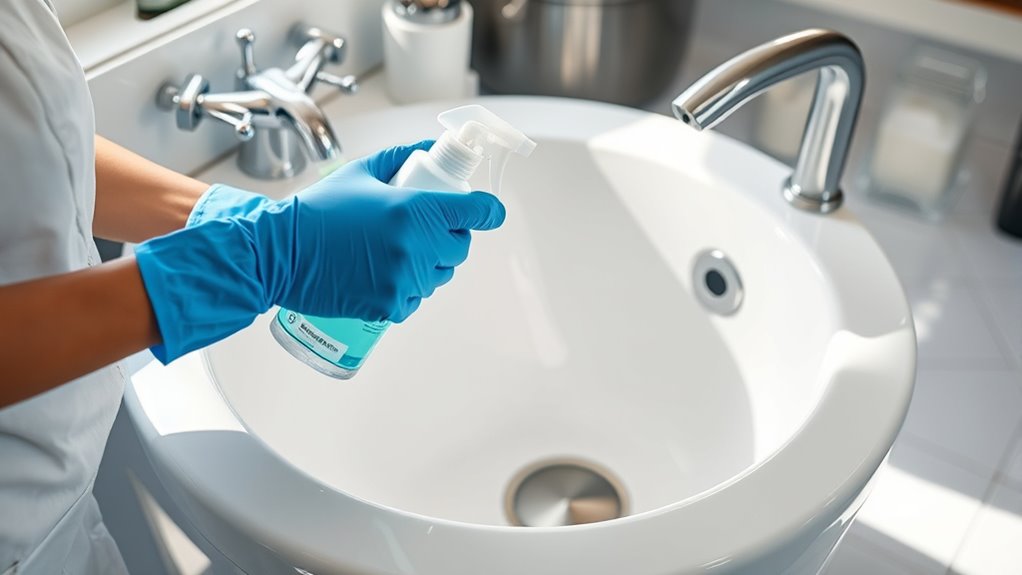
You need to make certain your staff understands proper sanitation procedures to keep pedicure tubs safe. Regular training sessions help reinforce standards and keep everyone up-to-date. Monitoring compliance standards ensures these protocols are consistently followed. Incorporating proper sanitation procedures into your training helps prevent salon infections effectively.
Proper Sanitation Procedures
Effective sanitation begins with thorough training of staff on proper protocols and standards. You must understand how different pedicure tub materials—acrylic, metal, or plastic—affect cleaning methods to ensure customer safety. Proper procedures include cleaning, disinfecting, and rinsing each time a client finishes, avoiding cross-contamination. Staff should be familiar with approved disinfectants that are compatible with your tub materials and effective against pathogens. Regularly review sanitation checklists to confirm compliance. To elevate standards, consider these key practices:
- Use validated cleaning agents suitable for your tub’s surface
- Follow manufacturer instructions for disinfectant contact time
- Maintain detailed sanitation logs for accountability
- Staying informed about industry transformations can help you adopt innovative sanitation solutions.
Regular Staff Training Sessions
Regular staff training sessions are essential to guarantee everyone understands and consistently follows sanitation protocols. Well-trained staff ensure pedicure tubs are properly sanitized, reducing infection risks and boosting customer confidence. Incorporate customer feedback to identify areas where sanitation might need improvement, reinforcing the importance of protocols during training. Consistent education helps staff stay updated on best practices, which directly impacts your salon’s reputation. When clients see staff prioritizing cleanliness, it enhances your salon marketing efforts by building trust and loyalty. Regular training also fosters a team culture that values hygiene, making sanitation a routine part of service. By investing in ongoing education, you demonstrate your commitment to client safety, leading to positive reviews and repeat business. This approach keeps your salon a clean, safe, and trusted environment.
Monitoring Compliance Standards
To guarantee sanitation protocols are consistently followed, it’s essential to actively monitor staff compliance with established standards. Regular compliance monitoring ensures that everyone adheres to proper sanitation practices and maintains regulatory oversight. Implementing routine checks helps identify gaps and reinforces accountability. You should develop clear procedures for supervisors to verify sanitation procedures, including disinfectant use and tub cleaning.
- Conduct periodic audits to verify adherence to protocols
- Use checklists to streamline compliance verification
- Provide real-time feedback to reinforce standards
Regular Inspection and Documentation for Compliance
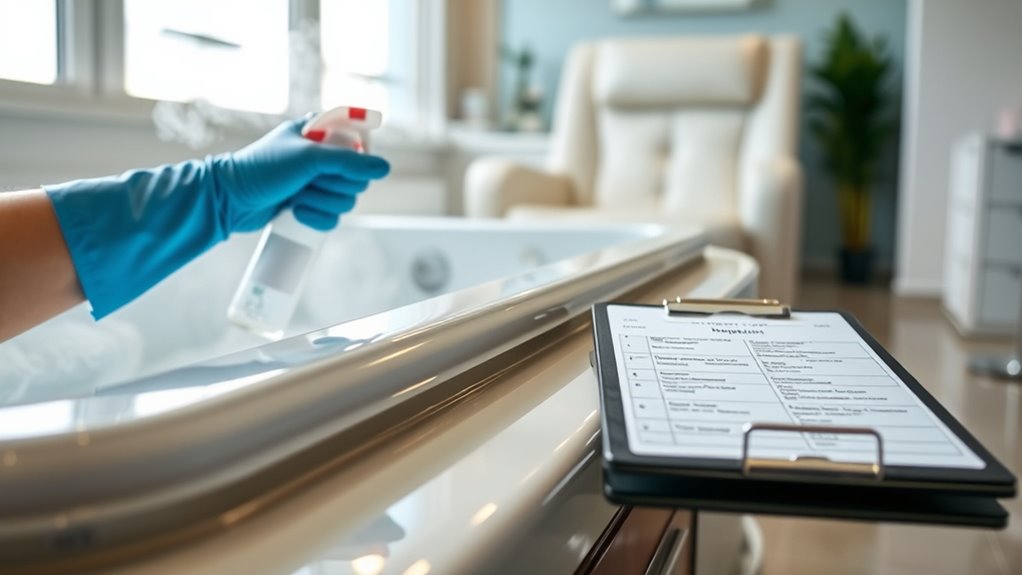
Since maintaining compliance requires consistent oversight, you should establish a routine of inspecting pedicure tubs regularly. Use inspection logs to document each check, noting the cleanliness, sanitation, and any maintenance issues. This creates a clear record of your efforts and helps identify recurring problems. Develop a compliance checklist to ensure all sanitation steps are followed consistently, such as disinfectant levels, filter cleanliness, and tub condition. Regular documentation not only helps you stay compliant with health standards but also provides evidence during inspections or audits. By keeping thorough records and conducting routine inspections, you demonstrate your commitment to client safety and reduce the risk of infections. Consistent oversight is key to maintaining a safe and hygienic salon environment.
Frequently Asked Questions
How Often Should Pedicure Tubs Be Sanitized During Daily Operations?
You should sanitize pedicure tubs after every client to follow the best practices and guarantee safety. Maintaining proper frequency guidelines prevents the spread of bacteria and fungi. Use appropriate disinfectants, thoroughly clean all surfaces, and follow manufacturer instructions. Consistent sanitation not only protects your clients but also upholds your salon’s reputation. Remember, diligent cleaning between appointments is essential to keep your salon hygienic and compliant with health standards.
Are There Eco-Friendly Disinfectants Suitable for Pedicure Tubs?
You’re wondering if eco-friendly disinfectants exist for pedicure tubs, and yes, they do. Biodegradable disinfectants and plant-based sanitizers offer effective cleaning without harmful chemicals. These solutions break down naturally, ensuring safer environments for clients and staff. Using such eco-friendly options not only reduces your salon’s carbon footprint but also builds trust, showing you’re committed to safety and sustainability—an important edge in today’s conscious market.
What Are the Signs Indicating a Pedicure Tub Needs Deep Cleaning?
You’ll want to deep clean your pedicure tub when you notice signs of mold or unpleasant odors lingering even after regular cleaning. These are clear indicators that bacteria and mold have built up, posing a risk to clients. Additionally, if you see soap scum, discoloration, or residue that won’t scrub away, it’s time for a thorough disinfecting. Regular deep cleaning guarantees a safe, hygienic environment for every client.
How Can Salons Prevent Cross-Contamination Between Clients?
You can prevent cross-contamination by always using fresh, disposable tools for each client and thoroughly sanitizing shared tools between uses. Maintain strict technician hygiene by washing your hands frequently and wearing gloves when necessary. Regularly disinfect pedicure tubs and surfaces, and avoid reusing towels or linens. These practices help protect clients, reduce infection risks, and guarantee a safe, hygienic salon environment.
What Are the Legal Requirements for Sanitation in Salons?
Think of legal compliance as the backbone of your salon’s reputation; without it, everything risks collapsing. You must follow sanitation standards outlined by local health departments and regulations, including proper cleaning, disinfecting, and maintaining pedicure tubs. Regular training for staff on these requirements is essential. Staying current with laws guarantees you provide safe services, protects your clients, and keeps your salon running smoothly without legal worries.
Conclusion
By consistently following proper sanitation protocols, you not only protect your clients from infections but also build trust and reputation. When you choose the right cleaning products and train your staff, cleanliness becomes second nature. Regular inspections ensure you stay compliant, creating a safe, hygienic environment. It’s a cycle of care and responsibility that keeps your salon thriving. Ultimately, your dedication to sanitation is what keeps your clients coming back, time and time again.


